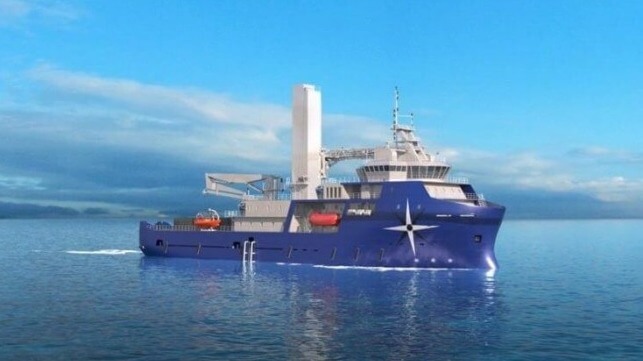Marco Polo Targets Offshore Wind Market with Newbuild CSOV

Singapore’s Marco Polo Marine wants to capitalize on the fast expanding Asia-Pacific offshore wind energy market after unveiling plans to build, own and operate a new commissioning service operation vessel (CSOV).
The company announced that construction of the $60 million vessel is expected to be completed in the first quarter of 2024 and will be financed through existing resources and borrowings from financial institutions. The vessel will be the first CSOV to be designed in Asia.
The decision to invest in the vessel comes after the company unveiled the designs in March this year and received keen interest from offshore wind farm developers.
By investing in the CSOV, Marco Polo intends to capitalize on the rising demand for support vessels required to service the booming offshore wind farm industry in the Asia–Pacific region, which is forecast to surpass Europe, the Middle East, and Africa (EMEA) in installed capacity over the next 15 years.
According to Global Wind Energy Council’s Global Wind Report 20221, the annual global offshore market is expected to grow by 49 percent from 21.1 GW in 2021 to 31.4 GW in 2026. The Asia-Pacific region took the lead in global wind power development last year and accounted for 84 percent of the new offshore installations worldwide in 2021.
Outside of China, Taiwan is one of the region’s fastest growing offshore wind markets and is expected to add 6.6 GW of offshore wind capacity by 2026. Vietnam, South Korea and Japan also have ambitious plans to develop offshore wind resources, with plans to add 2.2 GW, 1.7 GW and 1 GW of offshore wind power by 2026 respectively.
“We observed that the industry continues to grapple with a CSOV shortage globally and charter rates continue to surge as well as the need to combat climate change. We are optimistic about the ability to meet the rising demand for this vessel type,” said Sean Lee, Marco Polo Marine CEO.
The CSOV will be used in commissioning works during construction of offshore wind farms as well as their maintenance operations. Equipped with the latest walk-to-work motion compensated gangway for safe personnel transfer from the vessel to the turbines, it also has a 3D motion compensated crane to facilitate cargo transfer.
The vessel will also be equipped with hybrid battery-based energy storage systems that will reduce carbon emissions by up to 15 to 20 percent. It is designed to be methanol-ready.
According to Clarksons, charterers for offshore wind support vessels have started to secure ships earlier and for longer due to rising concerns of a shortage of suitable ships to meet the growth of the offshore wind farm market. In particular, CSOVs have seen higher utilization and day rates across all regions due to higher demand from both renewables and the oil and gas sector, as well as a rise in prices for newbuild vessels.
Within the offshore wind sector, construction of new projects as well as projects near the final commissioning date have been driving demand for CSOVs, resulting in a shortage in availability for the vessels.
Another Singaporean firm, Cyan Renewables, aims to become the first pure-play wind vessel owner in Asia. The company aims to invest $1 billion in a fleet of offshore wind vessels in the next three years, to include cable layers, service operation vessels and wind turbine installation vessels.
